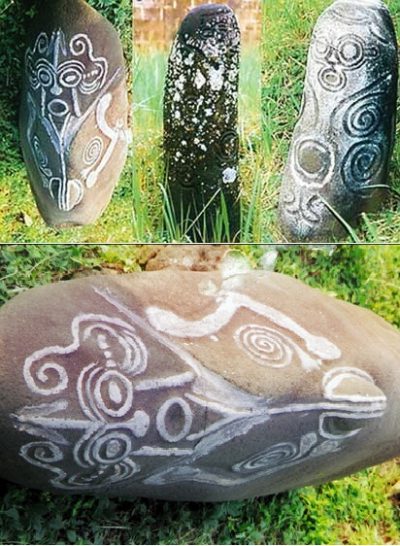Africa’s Lost Civilization at Ikom with Prof. Acholonu (Pt 3)

Ikom monoliths are evidence of a lost civilization (Image by Wikimedia Commons)
In this third installment of our exclusive interview, Professor Catherine Acholonu delves into the lost civilization of Africa. She examines the ancient origins of the Ikom Monoliths and the mysterious dwarf custodians of tradition. Acholonu also tells how she decoded the geometric code behind Nsibidi writing. Explore a forgotten era where science, spirituality, and sacred knowledge were one.
The Dwarfs and the Monoliths
FeelNubia: The oral history of Ikom mentions dwarfs as the original inhabitants of the area. Can you tell us more?
Professor Catherine Acholonu: Yes, the Ikom people migrated from Cameroon. When they arrived, the stone Monoliths were already there. The people they met, those who had carved the Monoliths, were dwarfs. These weren’t mythical beings; they were real people. Most stories you hear from the Niger Delta acknowledge that the first settlers in southern Nigeria were these dwarfs.
If you study old traditions gathered by researchers like Alabowa and others who documented folklore from various regions, you’ll find consistent references to these early inhabitants. As taller migrant groups began arriving, the dwarfs were gradually displaced. Yet, they remained present until relatively recently, around the 1960s, even during colonial rule.
As a child, I saw some of them. During a research project tracing the lineage of an 18th-century Nigerian slave, I uncovered fascinating insights. These dwarfs weren’t just cultural figures, they were the living embodiment of tradition. They carried out rituals, lifted taboos, and served as mediators between the spiritual and physical realms. People respected them deeply because they were considered vessels of sacred power. When they spoke, things happened. Their blessings restored lands; their curses brought ruin. They were the spiritual pulse of the communities they served.
The Hidden Messages of Nsibidi
FeelNubia: One of your groundbreaking discoveries was the symbol that brought you back to Ikom. How is this connected to the Nsibidi writing system?
Professor Acholonu: Absolutely. The local people told me the carvings were made by the “Stone Age” people. They were also known as the first age-grade. These early people worked with stone and were responsible for the inscriptions. They were dwarfs, and it’s from their writing that Nsibidi evolved.
The term “Nsibidi” in Igbo can be broken down into nsi, meaning dwarf, and bidi, meaning written. So, it translates to “written by the dwarfs.” Interestingly, the Ejagham people who use the Nsibidi symbols today adopted them, but don’t know their full meaning because the language of origin was Igbo.
These carvings were not randomly etched; they showed signs of advanced craftsmanship, perfect circles, squares, and triangles. You can’t create such geometric precision on stone without mechanical tools, which suggests a high level of technological advancement. Their symbols weren’t just art, they encoded geometry, astronomy, and spirituality.
Decoding the Stone Etchings
FeelNubia: How did you start decoding these ancient symbols?
Professor Acholonu: It began with recognizing shapes, squares, circles, and triangles. Only someone familiar with geometry would carve such forms. That alone pointed to a mathematically literate culture. From there, we began exploring what the symbols might mean beyond shapes.
Most of the Monoliths had faces, human faces, with open mouths. That detail intrigued me. Why were their mouths open? It wasn’t arbitrary. In Egyptian hieroglyphics, a slightly open mouth symbolizes “I am” (ego). When paired with another symbol, an n sound, it becomes ren, meaning “my name is.” So we found a pattern: each Monolith was saying something. They were declaring their identity. They had names. These were individuals, not just statues.
FeelNubia: So these weren’t generic carvings, they were representing people?
Professor Acholonu: Exactly. These people lived long ago, as spiritual leaders, teachers, and sages. They were god-men who walked with the divine in those ancient times. When the scriptures say, “Let us make man in our image,” I believe it refers to such beings, made in God’s likeness, connected directly to the spiritual source. And yes, many of them were dwarfs.
Messages from Ikom to Britain
FeelNubia: You mentioned using modern technology in your research. How did that help?
Professor Acholonu: We incorporated information technology to cross-reference multiple ancient scripts, Egyptian, Sumerian, Chinese, and others. I worked with a brilliant software engineer who created a linguistic database. With this, we input autographs from multiple ancient languages. Then, by matching the symbols, we identified recurring patterns and meanings.
One of our most helpful breakthroughs came from examining an artifact uncovered by British archaeologists. It showed remarkable symbolic parallels that tied back to the Monoliths. It confirmed that these ancient people were not only literate but were scientists, mathematicians, and spiritualists in one.
Next up in Part 4: Professor Acholonu discusses the celestial city of the gods, the Osun Grove revelations, and the prophetic dreams that guided her research toward decoding the deeper cosmology hidden within African stone inscriptions.
